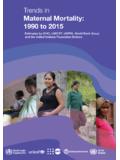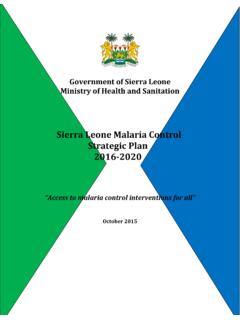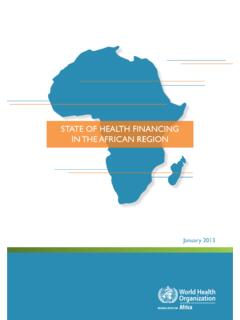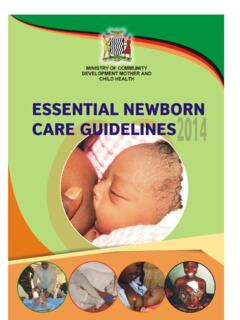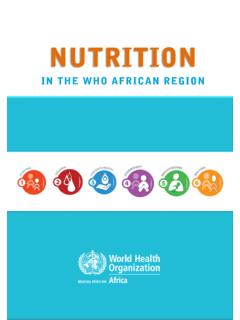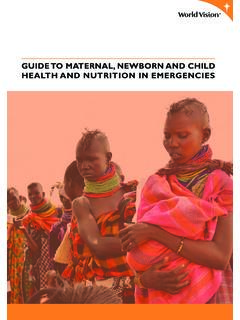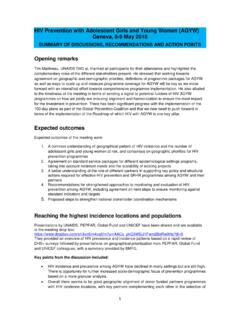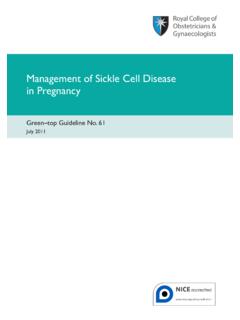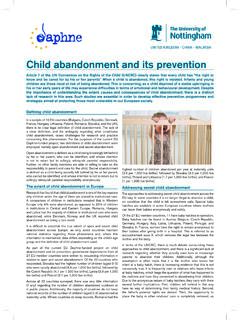Transcription of SEXUAL AND REPRODUCTIVE HEALTH FACT SHEET
1 Sub-Saharan Africa has the highest proportion (32%) of young people aged 10 24 years (7). Policies which do not permit or expressly guarantee youths and adolescents access to SEXUAL and REPRODUCTIVE HEALTH and rights can lead to unplanned pregnancies, increase in STIs and HIV, and unsafe abortions. At age 18, 78% of all females in Liberia and 77% of all females in Congo had had first SEXUAL intercourse. Similarly, 68% and 66% of males in Congo and Angola respectively had had first SEXUAL intercourse (Figure 1).
2 About 31% of females between the ages of 20 and 24 in the African region were married prior to age 18 (Figure 2). The top 5 countries in the region for early marriage were Niger (76%), Central African Republic (68%), Chad (67%), Mali (54%), and South Sudan (52%). The African region has the highest number of births to women aged 15-19 per 1000 women in that age group (99 births/1000 adolescent females) in comparison to other regions worldwide.
3 The global rate is 44 births per 1000 adolescent females (8). Central African Republic (229/1000) had the highest adolescent birth rate than elsewhere in the region while Algeria (9/1000) had the lowest (Figure 3). Females who start childbearing at an early age are at a higher risk of developing complications during pregnancy as well as infant mortality. This has a negative socio-economic impact on these females when compared to their peers who delay childbearing.
4 With age of SEXUAL debut, marriages, and childbearing starting quite early in the region, it is imperative to address adolescent SEXUAL and REPRODUCTIVE HEALTH and rights to forestall critical gaps. Comprehensive sexuality education for youths and adolescents will promote positive SEXUAL behavior and thus improve REPRODUCTIVE HEALTH . Maternal mortality ratio (MMR) in the African Region has declined from an estimated 857 maternal deaths per 1000 live births in 2000 to 525 deaths per 1000 live births in 2017 (2).
5 Despite this progress, this is still far from the global target of 140 maternal deaths per live births and progress remains unequal across countries. MMR ranges from 53 to 1,150 maternal deaths per 1000 live births in Seychelles and South Sudan contraceptive prevalence rate, modern methods, among married or in union women in Sub-Saharan Africa increased from in 2000 to in 2019. However, only 52% of women in this group have their need for family planning satisfied with modern methods (3).
6 Abortion can be provided legally upon request, with no justification requirement, up to a certain gestational limit in only 4 countries in the African region, Angola; Cabo Verde, Sao Tome & Principe and South Africa. Consequently, most of the abortions done in the countries where it is illegal are unsafe. It is estimated that - of maternal deaths annually in Sub-Saharan Africa are due to abortions (4).KEY FACTSThe WHO REPRODUCTIVE HEALTH Strategy, endorsed by the World HEALTH Assembly in 2004 and guided by internationally agreed human rights principles (1), specifies five core aspects of SEXUAL and REPRODUCTIVE HEALTH (SRH): improving antenatal, perinatal, postpartum and newborn care; providing high-quality services for family planning, including infertility services; eliminating unsafe abortion.
7 Combating sexually transmitted infections including HIV, REPRODUCTIVE tract infections, cervical cancer and other gynaecological morbidities; and promoting SEXUAL HEALTH . Additionally, the strategy highlights the importance of preventing and responding to violence against women for improving REPRODUCTIVE HEALTH universal access to SEXUAL and REPRODUCTIVE HEALTH and rights (SRHR) is a key component to achieving Sustainable Development Goals 3 and 5.
8 Indicators to measure the progress towards this goal have shown that the African region, though progressing based on interventions across the different countries, still lags behind the rest of the world and more effort is needed to achieve the goal. SEXUAL AND REPRODUCTIVE HEALTH FACT SHEETFGM remains a problem in the African Region, particularly in the Western and Eastern sub-regions. Approximately 95% of females aged 15-49 years in Guinea had undergone female genital mutilation (FGM) in 2018 (5).
9 Approximately million people are living with HIV in the African region and million new infections were recorded in 2018. About 79% of pregnant women living with HIV received antiretrovirals for prevention of mother to child transmission of HIV in 2018 (6)ADOLESCENT AND YOUTH SEXUAL AND REPRODUCTIVE HEALTH WHO AFRICAN REGION2To prevent unwanted pregnancies and empower women and adolescents in the region, women should be able access to family planning services.
10 Family planning services include counselling and provision of contraceptive methods. Modern methods of contraception include oral contraceptives, implants, injectable contraceptives, intrauterine devices (IUDs), condoms (male and female), emergency contraceptive pills, lactational amenorrhea method, basal body temperature method among 17% of all women in Sub-Saharan Africa and 23% of married or in union women have an unmet need for family planning (3).
